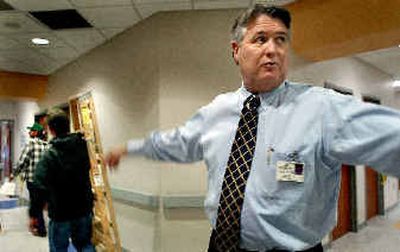Loan helps revive hospital

KELLOGG – When it was built nearly 50 years ago, Shoshone Medical Center offered not only the latest health care technology, including a state-of-the-art telephone system, but the building’s 18-inch concrete foundation also offered refuge as a bomb shelter.
Today, the structure is a medical monstrosity. The thick walls are almost impossible to upgrade with modern ventilation systems. Accessing pipes buried deep in the concrete isn’t easy, either. Even the bathrooms are hopelessly out of date and are too narrow for a wheelchair, hospital CEO Gary Moore said during a recent tour.
By the end of the month, patients won’t have to squeeze into the tight commodes and hospital maintenance staff won’t have to fret about finding parts for the obsolete elevator. The new Shoshone Medical Center is only days away from opening.
Just a few years ago, the thought of a new hospital seemed impossible: the hospital was deep in debt, had trouble attracting new patients and was located in both a floodplain and a Superfund site, Moore said. But fixing the old hospital and keeping it running for another decade would have cost $10 million.
Alan Richman, a Philadelphia-based mortgage broker, was hired to help the county hospital secure an $18.4 million loan to build a new facility. Richman recalled his first conversation with financiers about the project.
“They thought I was drunk,” he said.
Bonds are typically used to finance large capital projects for public facilities, but the Shoshone Medical Center would likely have trouble finding bidders, said Richman, the CEO of InnoVative Capital, which specializes in financing health care facilities.
“By and large, people don’t want to buy bonds for little hospitals in the middle of nowhere that don’t have cash,” he said.
At first, the only loans that seemed to be available came with interest rates higher than most credit cards. But the picture brightened after the hospital got its finances in order and was able to obtain federal designation in 2001 as a critical access hospital. Sterling Savings Bank, of Spokane, also offered a $1 million credit lifeline. The critical access designation allows the hospital better Medicare and Medicaid reimbursement rates than what’s available to hospitals in larger cities. With more than 60 percent of the hospital’s patients enrolled in one of the federal health programs, the hospital had a relatively stable financial future.
“It’s a tremendous reimbursement mechanism,” Richman said of the higher Medicare and Medicaid rates offered to critical access hospitals.
Richman also tapped into a little-used U.S. Department of Housing and Urban Development mortgage insurance program aimed at helping hospitals obtain federally guaranteed mortgages. The interest rate on the 25-year loan was just under 6 percent, Richman said.
Despite the hospital’s earlier “extreme credit profile,” Richman said the federal guarantee made all the difference in obtaining an affordable loan.
Financiers also expect the new hospital will increase business. Currently, about half the potential patient pool obtains medical care in Coeur d’Alene or Spokane.
“It’s not the concept like Field of Dreams: ‘Build it and they will come,’ ” Richman said. “There’s an immediate demand. There are services not being provided to the masses because the masses did not want to go there.”
Moore, the hospital CEO, said the clean, bright facility was designed to inspire confidence and to keep more patients close to home.
“They think over the hill’s better,” Moore said. “But people in Coeur d’Alene think they’ve got to go to Spokane. People in Spokane think they’ve got to go to Seattle” for medical care.
The new, 42,000-square-foot hospital is expected to take its first patient sometime at the end of the month. Although the facility will have 25 patient beds, the building is designed with an eye on the future – much of the new space is devoted to trauma care, radiology and outpatient services, such as treating hernias, cataracts and orthopedic problems, Moore said.
One sign of the times is a decontamination room near the ambulance bay. The room is becoming standard in new hospitals and is used to clean incoming patients who are suspected of living in homes contaminated with methamphetamine, Moore said.
Ever since the county’s mining industry collapsed in the early 1980s, the region has struggled with high unemployment and a sluggish economy. But the relatively inexpensive property values combined with North Idaho’s scenery has spawned a vibrant tourism industry. Two ski resorts in the area are expanding, a bicycle trail that opened last year is attracting thousands of riders and a major new golf course is planned.
The new hospital will be a “fantastic” help in the county’s continuing effort to recruit new businesses and residents, said Vince Rinaldi, executive director of the Silver Valley Economic Development Corp. “It’s really important for our future growth.”